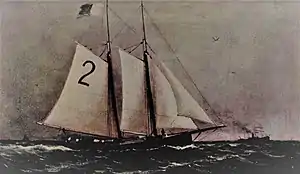Eden D. Jordan
The Eden D. Jordan was a 19th-century Boston pilot boat built in 1883 for Captain Thomas Cooper. While in the Boston service she was assigned the "Number 2," that was displayed on her mainsail. In 1892, she was sold to the New York Sandy Hook pilots. She was one of the last of the pilot-boats that were discarded in an age of steam and electricity in 1896.
 Pilot Boat Eden D. Jordan, No. 2; painting by Hendricks A. Hallett of Boston. | |
| History | |
|---|---|
| Name: | Eden D. Jordan |
| Namesake: | Eben Dyer Jordan |
| Owner: | Captain Thomas Cooper |
| Builder: | Ambrose A. Martin |
| Launched: | 1883 |
| Out of service: | February 1, 1896 |
| Fate: | Sold |
| General characteristics | |
| Class and type: | schooner |
| Tonnage: | 65-tons TM[1] |
| Length: | 73 ft 2 in (22.30 m) |
| Beam: | 21 ft 2 in (6.45 m) |
| Depth: | 9 ft 8 in (2.95 m) |
| Propulsion: | Sail |
Construction and service
In 1883, the Eden D. Jordan, No. 2, was built by Ambrose A. Martin in East Boston. Her lines were based on the Dennison J. Lawlor design. Her namesake was Eben Dyer Jordan, the founder of the Jordan Marsh department stores.[2] Mr. Jordan gave Captain Cooper a set of signal flags for use on his pilot-boat.[3]
In the Record of American and Foreign Shipping, from 1884 to 1900, she was listed as: 65-tons; built in 1883, owned and mastered by Captain Thomas Cooper, built in East Boston, her hailing port was Boston; Length was 73.2 feet; Breadth was 21.2 feet; and Depth was 9.8 feet.[1]
On February 24, 1886, pilot-boat Eben D. Jordan left Boston for her station. Two days later she was caught up in a heavy winter storm. She lost her main boom and staysail. She drifted to Block Island, then to Vineyard Haven, Massachusetts, and then returned safely into the Boston harbor.[4]
In November 1888, during a heavy winter storm, the Eben D. Jordan came into the Boston harbor. Captain Reed reported seeing three boats going ashore between Freshwater Cove and Magnolia, Massachusetts.[5]
In 1892, the Eben D. Jordan, was sold to the New York Harbor pilot group led by George Washington Beebe.[2] At that time the number on her mainsail changed from No. 2 to No. 9.
In 1893, while on station offshore off Barnegat, New Jersey, she was run down when struck by the steamship SS. Saginaw during a gale. She survived the collision, was salvaged, and placed back into service.[3]:p85
In February 1895, the Jordan was carried 75 miles beyond the Highlands in a winter storm. A wave of 30 feet washed over her smashing her yawl, her boom and flooding the cabin. Her trysail was carried away. She arrived at Stapleton, Staten Island in tow with the help of Pilot Andrew Jackson.[6]
End of service
On February 1, 1896, the New York Pilots discarded sixteen sailboats and moved them to the Erie Basin in Brooklyn. They were replaced with steam pilot boats. The Eben D. Jordan, was sold for $5,500.[7]
In 1898, the Eben D. Jordan was sold to the Brunswick, Georgia pilots.[2] The Mobile, Alabama Bar and Bay Pilots' Association acquired her in December 1906 as a replacement for the pilot-boat Louise F. Harper, which was lost in a September storm.[2][8]
On April 8, 1912, the Eben D. Jordan went to Havana where she was sold to a Cuban owner.[2][9]
References
- "Index to Ship Registers". research.mysticseaport.org. Mystic seaport. Retrieved 23 February 2020.
- "Pilot Schooner Alabama" (PDF). Historic American Engineering Record. Washington, DC. Retrieved 18 Nov 2020.
- Eastman, Ralph M. (1956). Pilots and pilot boats of Boston Harbor. Boston, Massachusetts: Second Bank-State Street Trust Company.
- "Eben D. Jordan Hard Times". The Boston Globe. Boston, Massachusetts. 8 Mar 1886. p. 5. Retrieved 18 Nov 2020.
- "High Winds and Tides". Democrat and Chronicle. Rochester, New York. 27 Nov 1888. p. 1. Retrieved 18 Nov 2020.
- "The E. D. Jordan Arrives in Tow". The Evening World. New York, New York. 13 February 1895. Retrieved 11 August 2020.
- "Not Up To Date. Why New York Pilots Are Discarding Sailboats". The Standard Union. Brooklyn, New York. 1 Feb 1896. p. 7. Retrieved 8 Sep 2020.
- "Mobile Pilots Have New Boat". Pensacola News Journal. Pensacola, Florida. 31 Oct 1906. p. 2. Retrieved 18 Nov 2020.
- "Mexican Sleuths On Track Of Filibusters". The Tennessean. Nashville, Tennessee. 5 Jan 1912. p. 7. Retrieved 18 Nov 2020.